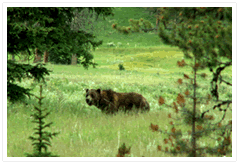
I've just skimmed this reading from Friends of World Heritage, and I got impressed about this impressive spot, located on the central Sierra Nevada of California. Indeed, Yosemite National Park is a place of such beauty that it has been called a paradise on earth. People love it for many different reasons, and for those responsible for serving them while protecting this cherished place, the job is a constant challenge.
Yosemite National Park is a land of awe-inspiring cliffs and domes; the beautiful, glacially-carved Yosemite Valley; five of the world’s highest known waterfalls; and groves of giant sequoia, the world’s largest living things. The park has a history of human association that includes its occupation by Miwok and other indigenous peoples, and its ties to the beginnings and struggles of the conservation movement, the development and nurturing of the concepts of protected areas and national parks and the government institutions established to manage and preserve them.
Although Yosemite National Park was designated a World Heritage site in 1984, its significance had been widely recognized and led to its protection even before a national park was created in 1890 on part of the present-day site. In 1864 (nearly eight years before Yellowstone was set aside as the world’s first national park), Yosemite Valley and Mariposa Big Tree Grove were granted to the State of California by the United States Congress, ‘for public use, resort and recreation’, ‘inalienable for all time.’ In 1906, Congress accepted transfer of the Grant back to the United States and added it to the already established Yosemite National Park, managed – like other parks in the west – by the U.S. Army. Only later, following public debates over the cutting of giant sequoias in Yosemite and other simmering issues at national parks, did Congress establish a National Park Service. Today, the National Park Service is making even greater efforts to manage the natural and cultural heritage it is charged with preserving. From systematic monitoring of natural resources, to creating environmentally sound infrastructure (such as roads and visitor stations) to handle its huge influx of tourists, to dealing with regular wildfires, the Yosemite Park management has been responding to changes in the park for more than a century.Additionally, the Park Service has made a point to improve its relationship with the many Native American people that live around the park. Many of these – from seven different tribes – remain active in the park’s management and activities. Some work for the park, providing visitor programs and professional services, and some are long-serving craft workers or interpreters who remain involved in educating millions on the ways and cultures of Yosemite’s indigenous peoples. A cultural center, under construction, will be a place where Native Americans can maintain their culture and observe their traditions in the Yosemite Valley. “Now, after almost thirty years of working on this, we can see that our efforts and dreams will come true,” says Jay Johnson, Tribal Elder and descendant of the Ahwahneecis (Yosemite) Tribe. “We will have use of the Indian Village in Yosemite Valley called Wahhoga.”Yosemite National Park draws visitors from around the world. From climbers scaling the face of El Capitan, to photographers recreating the works of Ansel Adams, to campers swimming in the Merced River and naturalists skirting the meadows and riparian corridor in search of birds and wild flowers, it is easy to understand why Yosemite welcomes 3.5 million visitors annually. But there is more here to know and understand. Yosemite is a source of pride, part of the nation’s identity, and a central institution in the effort to preserve its natural and cultural heritage.
So, don't forget we have such an awesome destination near by Mexico!


0 Comments:
Post a Comment
<< Home